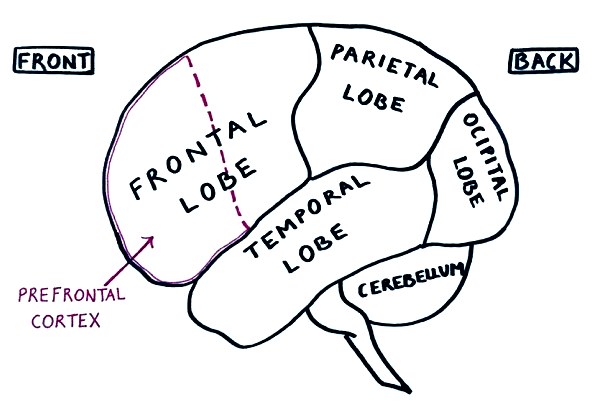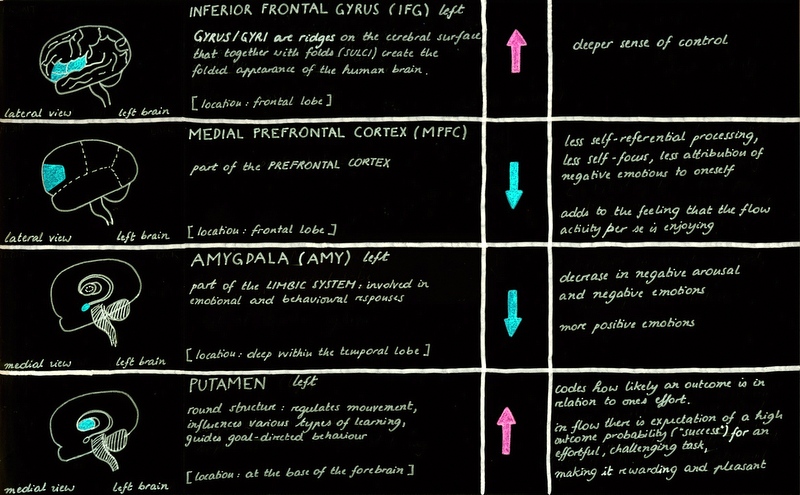Mindflow
Brain activity during flow

Short recap
Flow is a mental state featuring high focus, absorption and peak performance… not to forget its positive impact on wellbeing and happiness.
I’d like to better understand this elusive state. How can it be harnessed and employed to our benefit?
But first: What exactly happens in the brain during flow?
THH of flow
Arne Dietrich, Professor of Cognitive Neuroscience at the American University of Beirut, proposed a hypothesis for what might happen in our brain when we experience flow: the transient hypofrontality hypothesis (THH) of flow.
Sounds complex. Let’s deconstruct it.
“Transient” means it is only a temporary state, “hypo” is Greek for “less”, and “frontality” refers to the region of the brain that is located at the very front of each brain hemisphere: the ‘frontal lobe’ of the brain.
More specifically, the neural tissue that covers the very front part of the frontal lobe is the ‘prefrontal cortex’.

Reconstructing now, the hypothesis states that:
For a certain period of time, while we are in flow, less ‘brain energy’ flows into specific areas of the brain, which are located at the front: namely, the higher cognitive centers of the brain.
This means, less neural activity is taking place in the prefrontal cortex, which is usually involved in things like planning, judgement, decision-making, problem-solving and self-control (basically everything subsumed under the label “explicit executive functions”).
As a result, under the condition of flow, analytical and self-referential thinking is temporarily ‘suppressed’ or ‘stopped’ from interfering while we perform a task or activity.
If this is the case, where does spare brain energy go to?
According to Dietrich, brain resources are freed up for the brain’s implicit system: for faster processing of information and automatic action, which translates into heightened efficiency.
Presumably, this change in neural activity in the brain, is what we experience as ‘the altered state of consciousness’ typical of flow, manifested by a distorted sense of time, high concentration on a limited field of attention, a sense of control, and complete absorption in something to the extent of losing awareness of everything else that surrounds you.
Imaging the brain
The transient hypofrontality hypothesis (THH) finds support in several studies that make use of functional magnetic resonance imaging (fMRI).
In lab experiments of this kind, participants are given a task aiming to induce flow. Simultaneously, their brain activity is monitored and measured by detecting changes associated with blood flow.
After the experiment, participants complete a questionnaire on their subjective experience of flow, covering aspects and sensations typical of flow.
Cases where participants’ responses suggest they did not enter a flow state during the experiment are then excluded from the data analysis.
Quick maths
For example, in a study conducted by Ulrich et al. (2014), participants were given mental arithmetic tasks. Task difficulty was automatically and continuously adjusted to individual skill level. Remember: an optimal challenge-skill balance strongly facilitates flow.
The “flow” condition is then compared to what happens in the brain when participants experience “boredom” or “overload” (comparison conditions).
Results
|
The experience of flow is associated with an increase* in neural activity in:
At the same time, neural activity decreases* in:
*increases and decreases in brain activity are always relative to the conditions of “boredom” and “overload”. There is also a significant association between participants’ subjective reportings of the flow experience and changes in neural activity in the IFG, AMY, and, a trend towards significance, in the MPFC. |

So, what people commonly experience as flow and how they describe it, really is reflected in the specific brain regions and functions that are ‘activated’ or ‘deactivated’ during flow.
Epilog on Mindfulness
How does flow relate to yet another prominent state of mind, mindfulness?
In both states individuals fully engage with the present and experience a sense of control.
But contrary to flow, mindfulness is a mental practice that deliberately focuses your attention to your thoughts and sensations of the moment. Self-referential thinking is intended.
And, while in flow you lose awareness, – losing “the inner observer”, as you’re fully immersed in a task – , in mindfulness, you want to cultivate an outside observer to your own self, by being aware of your own awareness.
The exercise of mindfulness consists in controlling your thoughts and not allowing your mind to wander.
Although mindfulness seems to activate regions of the brain “opposite” to flow, it is interesting that, when you engage in a mindfulness practice or intervention first (for instance meditation), you are more likely to experience flow in your activity thereafter.
Even if that sounds paradoxical, it suggests that practicing self-observation might ultimately help you lose your inner observer so as to get to flow.
Written and published from October to November 2020
by Jessica
|
On a final note So far THH is supported by several studies on flow experiences in video games₁, memory and arithmetic tasks and shooting using Electroencephalography (EEG), in arithmetic tasks₂ using fMRI and in verbal fluency tests₃ using near-infrared spectroscopy (fNIRS). However, an alternative theory proposed by Weber & Tamborini (2009)₄, the synchronisation theory of flow (STF), disputes THH, arguing for the presence of strong frontal activity in many flow-like activities or states (like hypnosis). Open debate. |
₁Núñez Castellar, E. P., Antons, J. N., Marinazzo, D., & Van Looy, J. (2019). Mapping attention during gameplay: Assessment of behavioral and ERP markers in an auditory oddball task. Psychophysiology, 56(7), e13347.
₂Ulrich, M., Keller, J., & Grön, G. (2016). Neural signatures of experimentally induced flow experiences identified in a typical fMRI block design with BOLD imaging. Social cognitive and affective neuroscience, 11(3), 496-507.
₃Hirao, K. (2014). Prefrontal hemodynamic responses and the degree of flow experience among occupational therapy students during their performance of a cognitive task. Journal of Educational Evaluation for Health Professions, 11.
₄Weber, R., Tamborini, R., Westcott-Baker, A., & Kantor, B. (2009). Theorizing flow and media enjoyment as cognitive synchronization of attentional and reward networks. Communication Theory, 19(4), 397-422.
Subscribe to My Newsletter !
List of references I used in this article:
Gold, J., & Ciorciari, J. (2020). A Review on the Role of the Neuroscience of Flow States in the Modern World. Behavioral Sciences, 10(9), 137.
Kuhlkamp, N. (2015). How to promote flow experiences at work: The impact of a mindfulness-based intervention and the role of trait mindfulness. Yayımlanmamış Yüksek Lisans Tezi) Netherlands: Faculty of Psychology and Neuroscience, Maastricht University.
Reid, D. (2011). Mindfulness and flow in occupational engagement: Presence in doing. Canadian Journal of Occupational Therapy, 78(1), 50-56.
Sheldon, K. M., Prentice, M., & Halusic, M. (2015). The experiential incompatibility of mindfulness and flow absorption. Social Psychological and Personality Science, 6(3), 276-283.
Ulrich, M., Keller, J., Hoenig, K., Waller, C., & Grön, G. (2014). Neural correlates of experimentally induced flow experiences. Neuroimage, 86, 194-202.